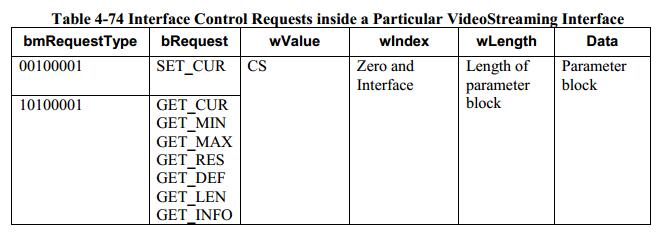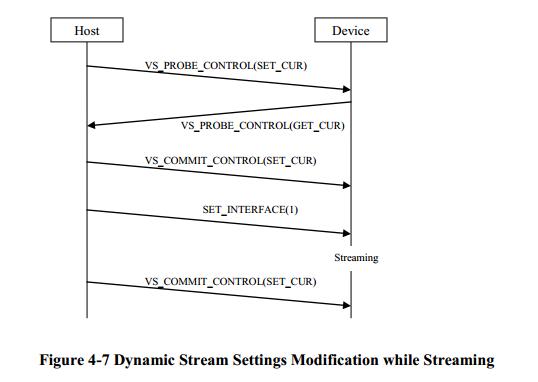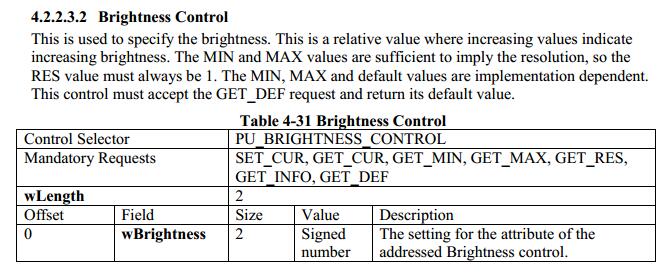UVC 攝像頭驅動(三)配置攝像頭,實時資料採集
前面分析了 UVC 攝像頭的硬體模型和描述符,對於一個 usb 攝像頭來說,內部大概分為一個 VC 介面和一個 VS 介面,VC 介面內部有許多 unit 和 terminal 用來“控制”攝像頭,比如我們可以通過 Process unit 設定白平衡、曝光等等。對於 VS 介面來說,標準 VS 介面往往含有許多個設定,每一個設定都包含一個實時傳輸端點,雖然它們的端點地址可能相同,但是它們的最大傳輸包大小不同,在 Class specific VS 介面中,包含多個 Format ,每一個 Format 包含多個 Frame ,Format 指的 YUYV MJPG 等等,Frame 就是各種解析度 480*320 640 * 480 等等。以上這些資訊,都是通過分析描述符來獲得。
VideoStreaming Requests
參考 UVC 1.5 Class specification 4.3 節

我們需要使用控制傳輸來和VS通訊,Probe and commit 設定,請求格式參考上圖。
- bmRequestType 請求型別,參考標準USB協議
- bRequest 子類,定義在 Table A-8
- CS ,Control Selector ,定義在 Table A-16 ,例如是probe 還是 commit
- wIndex 高位元組為0,低位元組為介面號
- wLength 和 Data 和標準USB協議一樣,為資料長度和資料
引數設定的過程需要主機和USB裝置進行協商, 協商的過程大致如下圖所示:
- Host 先將期望的設定傳送給USB裝置(PROBE)
- 裝置將Host期望設定在自身能力範圍之內進行修改,返回給Host(PROBE)
- Host 認為設定可行的話,Commit 提交(COMMIT)
- 設定介面的當前設定為某一個設定
那麼協商哪些資料?這些資料在哪裡定義?參考Table 4-75 ,裡面包含了使用哪一個Frame 哪一個 Frame 幀頻率,一次傳輸包大小等等的資訊。
參考程式碼:
static int myuvc_try_streaming_params(struct myuvc_streaming_control *ctrl)
{
__u8 *data VideoControl Requests
這裡我們主要分析 VC 接口裡的 Processing Unit Control Requests 以亮度為例:

static void myuvc_set_le_value(__s32 value, __u8 *data)
{
int bits = 16;
int offset = 0;
__u8 mask;
data += offset / 8;
offset &= 7;
for (; bits > 0; data++) {
mask = ((1LL << bits) - 1) << offset;
*data = (*data & ~mask) | ((value << offset) & mask);
value >>= offset ? offset : 8;
bits -= 8 - offset;
offset = 0;
}
}
static __s32 myuvc_get_le_value(const __u8 *data)
{
int bits = 16;
int offset = 0;
__s32 value = 0;
__u8 mask;
data += offset / 8;
offset &= 7;
mask = ((1LL << bits) - 1) << offset;
for (; bits > 0; data++) {
__u8 byte = *data & mask;
value |= offset > 0 ? (byte >> offset) : (byte << (-offset));
bits -= 8 - (offset > 0 ? offset : 0);
offset -= 8;
mask = (1 << bits) - 1;
}
/* Sign-extend the value if needed. */
value |= -(value & (1 << (16 - 1)));
return value;
}
/* 參考:uvc_query_v4l2_ctrl */
int myuvc_vidioc_queryctrl (struct file *file, void *fh,
struct v4l2_queryctrl *ctrl)
{
__u8 type = USB_TYPE_CLASS | USB_RECIP_INTERFACE;
unsigned int pipe;
int ret;
u8 data[2];
if (ctrl->id != V4L2_CID_BRIGHTNESS)
return -EINVAL;
memset(ctrl, 0, sizeof *ctrl);
ctrl->id = V4L2_CID_BRIGHTNESS;
ctrl->type = V4L2_CTRL_TYPE_INTEGER;
strcpy(ctrl->name, "MyUVC_BRIGHTNESS");
ctrl->flags = 0;
pipe = usb_rcvctrlpipe(udev, 0);
type |= USB_DIR_IN;
/* 發起USB傳輸確定這些值 */
ret = usb_control_msg(udev, pipe, GET_MIN, type, PU_BRIGHTNESS_CONTROL << 8,
ProcessingUnitID << 8 | myuvc_control_intf, data, 2, 5000);
if (ret != 2)
return -EIO;
ctrl->minimum = myuvc_get_le_value(data); /* Note signedness */
ret = usb_control_msg(udev, pipe, GET_MAX, type, PU_BRIGHTNESS_CONTROL << 8,
ProcessingUnitID << 8 | myuvc_control_intf, data, 2, 5000);
if (ret != 2)
return -EIO;
ctrl->maximum = myuvc_get_le_value(data); /* Note signedness */
ret = usb_control_msg(udev, pipe, GET_RES, type, PU_BRIGHTNESS_CONTROL << 8,
ProcessingUnitID << 8 | myuvc_control_intf, data, 2, 5000);
if (ret != 2)
return -EIO;
ctrl->step = myuvc_get_le_value(data); /* Note signedness */
ret = usb_control_msg(udev, pipe, GET_DEF, type, PU_BRIGHTNESS_CONTROL << 8,
ProcessingUnitID << 8 | myuvc_control_intf, data, 2, 5000);
if (ret != 2)
return -EIO;
ctrl->default_value = myuvc_get_le_value(data); /* Note signedness */
printk("Brightness: min =%d, max = %d, step = %d, default = %d\n", ctrl->minimum, ctrl->maximum, ctrl->step, ctrl->default_value);
return 0;
}
/* 參考 : uvc_ctrl_get */
int myuvc_vidioc_g_ctrl (struct file *file, void *fh,
struct v4l2_control *ctrl)
{
__u8 type = USB_TYPE_CLASS | USB_RECIP_INTERFACE;
unsigned int pipe;
int ret;
u8 data[2];
if (ctrl->id != V4L2_CID_BRIGHTNESS)
return -EINVAL;
pipe = usb_rcvctrlpipe(udev, 0);
type |= USB_DIR_IN;
ret = usb_control_msg(udev, pipe, GET_CUR, type, PU_BRIGHTNESS_CONTROL << 8,
ProcessingUnitID << 8 | myuvc_control_intf, data, 2, 5000);
if (ret != 2)
return -EIO;
ctrl->value = myuvc_get_le_value(data); /* Note signedness */
return 0;
}
/* 參考: uvc_ctrl_set/uvc_ctrl_commit */
int myuvc_vidioc_s_ctrl (struct file *file, void *fh,
struct v4l2_control *ctrl)
{
__u8 type = USB_TYPE_CLASS | USB_RECIP_INTERFACE;
unsigned int pipe;
int ret;
u8 data[2];
if (ctrl->id != V4L2_CID_BRIGHTNESS)
return -EINVAL;
myuvc_set_le_value(ctrl->value, data);
pipe = usb_sndctrlpipe(udev, 0);
type |= USB_DIR_OUT;
ret = usb_control_msg(udev, pipe, SET_CUR, type, PU_BRIGHTNESS_CONTROL << 8,
ProcessingUnitID << 8 | myuvc_control_intf, data, 2, 5000);
if (ret != 2)
return -EIO;
return 0;
}資料採集
資料採集時,我們需要和標準VS介面設定裡的實時端點通訊獲取資料,分配、設定、提交URB。
以 640*320 解析度的影象為例,每一個畫素16bit,因此一幀影象佔用空間 640*320*2位元組 ,對於我的攝像頭一次傳輸,3060位元組。需要注意的是,標準UVC攝像頭驅動中限制了一個URB的Buffer數量最大為32個,因此一個URB能承載的資料為 3060 * 32 ,經過計算,一幀影象資料需要多個 URB 來傳輸。因此在將影象資料拷貝到使用者空間Buffer時候,可能在某一個URB包含兩幀影象的資料,需要不要處理完前一幀就把第二幀影象資料丟棄了,那樣會造成影象資料丟失。
static int myuvc_alloc_init_urbs(void)
{
u16 psize;
u32 size;
int npackets;
int i,j;
struct urb *urb;
//struct urb *urb;
psize = 3060; /* 實時傳輸端點一次能傳輸的最大位元組數 */
size = 614400; /* 一幀資料的最大長度 */
npackets = DIV_ROUND_UP(size, psize);
if (npackets > 32)
npackets = 32;
myprintk("psize %d npackets %d\n",psize,npackets);
size = psize * npackets;
for (i = 0; i < 5; ++i) {
/* 1. 分配usb_buffers */
urb_buffer[i] = usb_alloc_coherent(
myuvc_udev, size,
GFP_KERNEL | __GFP_NOWARN, &urb_dma[i]);
/* 2. 分配urb */
myurb[i] = usb_alloc_urb(npackets, GFP_KERNEL);
if (!urb_buffer[i] || !myurb[i])
{
//myuvc_uninit_urbs();
myprintk("alloc buffer or urb failed\n");
return -ENOMEM;
}
}
/* 3. 設定urb */
for (i = 0; i < 5; ++i) {
urb = myurb[i];
urb->dev = myuvc_udev;
urb->context = NULL;
urb->pipe = usb_rcvisocpipe(myuvc_udev, 0x81);
urb->transfer_flags = URB_ISO_ASAP | URB_NO_TRANSFER_DMA_MAP;
urb->interval = 1;
urb->transfer_buffer = urb_buffer[i];
urb->transfer_dma = urb_dma[i];
urb->complete = myuvc_video_complete;
urb->number_of_packets = npackets;
urb->transfer_buffer_length = size;
for (j = 0; j < npackets; ++j) {
urb->iso_frame_desc[j].offset = j * psize;
urb->iso_frame_desc[j].length = psize;
}
}
return 0;
}static void myuvc_video_complete(struct urb *urb)
{
u8 *src;
//u8 *dest;
int ret, i;
int len;
int maxlen;
// int nbytes;
// struct myuvc_buffer *buf;
myprintk("video complete\n");
switch (urb->status) {
case 0:
break;
default:
myprintk("Non-zero status (%d) in video "
"completion handler.\n", urb->status);
return;
}
for (i = 0; i < urb->number_of_packets; ++i) {
if (urb->iso_frame_desc[i].status < 0) {
myprintk("USB isochronous frame "
"lost (%d).\n", urb->iso_frame_desc[i].status);
continue;
}
src = urb->transfer_buffer + urb->iso_frame_desc[i].offset;
//dest = myuvc_queue.mem + buf->buf.m.offset + buf->buf.bytesused;
len = urb->iso_frame_desc[i].actual_length;
myprintk("len %d\n",urb->iso_frame_desc[i].actual_length);
/* 判斷資料是否有效 */
/* URB資料含義:
* data[0] : 頭部長度
* data[1] : 錯誤狀態
*/
if (len < 2 || src[0] < 2 || src[0] > len)
continue;
/* Skip payloads marked with the error bit ("error frames"). */
if (src[1] & UVC_STREAM_ERR) {
myprintk("Dropping payload (error bit set).\n");
continue;
}
/* 除去頭部後的資料長度 */
len -= src[0];
/* 緩衝區最多還能存多少資料 */
//maxlen = buf->buf.length - buf->buf.bytesused;
//nbytes = min(len, maxlen);
/* 複製資料 */
//memcpy(dest, src + src[0], nbytes);
//buf->buf.bytesused += nbytes;
/* 判斷一幀資料是否已經全部接收到 */
if (len > maxlen) {
//buf->state = VIDEOBUF_DONE;
}
/* Mark the buffer as done if the EOF marker is set. */
if (src[1] & UVC_STREAM_EOF) {
myprintk("Frame complete (EOF found).\n");
if (len == 0)
myprintk("EOF in empty payload.\n");
//buf->state = VIDEOBUF_DONE;
}
}
/* 再次提交URB */
if ((ret = usb_submit_urb(urb, GFP_ATOMIC)) < 0) {
myprintk("Failed to resubmit video URB (%d).\n", ret);
}
}

